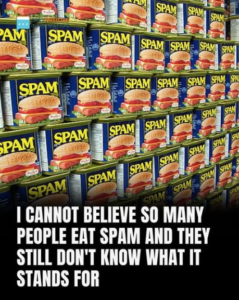The word spam has become synonymous with unwanted emails, junk messages, and digital clutter—but where did it come from, and why do we call it that?
The origins of the term spam in the context of unwanted digital communication can be traced back to a quirky source: a 1970 sketch by the British comedy group Monty Python. In this sketch, a group of patrons in a diner attempts to order food, but nearly every item on the menu includes SPAM (the canned meat product made by Hormel). No matter what the customers ask for, the waitress insists on including SPAM, repeating the word over and over again. Meanwhile, a group of Vikings in the background chants “SPAM, SPAM, SPAM, SPAM…” louder and louder, eventually drowning out the conversation entirely.
This sketch became a cult classic, especially among early internet users and tech enthusiasts who frequented forums and message boards in the 1980s and 1990s. These early digital communities—especially those on platforms like Usenet—adopted spam to describe disruptive or repetitive messages that “drowned out” meaningful conversation, much like the relentless chanting in the Monty Python skit.
Over time, the term evolved. In the early days of the internet, spamming referred to the act of flooding a discussion group or chatroom with meaningless messages. Then, as email became more widespread in the late 1990s and early 2000s, spam became the go-to term for unsolicited commercial messages—typically bulk emails sent to promote products, scams, or phishing attempts.
Interestingly, while spam in the digital sense is now almost universally understood to mean junk communication, Hormel (the makers of SPAM) has had a complicated relationship with the term. The company has acknowledged the cultural significance of the Monty Python sketch and the term’s adoption by internet users, but they also take care to differentiate between their product—still widely consumed around the world—and the digital nuisance.
The popularity of the term also reflects the culture of early internet communities, which were heavily influenced by humor, satire, and a do-it-yourself spirit. Borrowing from Monty Python was just one example of how internet pioneers shaped the language and customs of the online world in playful, creative ways. Other examples from this era include “trolls” (disruptive posters), “flame wars” (heated online arguments), and “lurkers” (people who read but don’t post).
Today, spam is not just limited to email—it shows up in text messages, social media comments, fake reviews, and even robocalls. But regardless of the form it takes, the idea remains the same: unwanted, repetitive content that gets in the way of real communication.
So, next time you delete a junk email or report a spammy comment, remember that it all goes back to a plate of canned meat, a stubborn waitress, and a group of singing Vikings.

